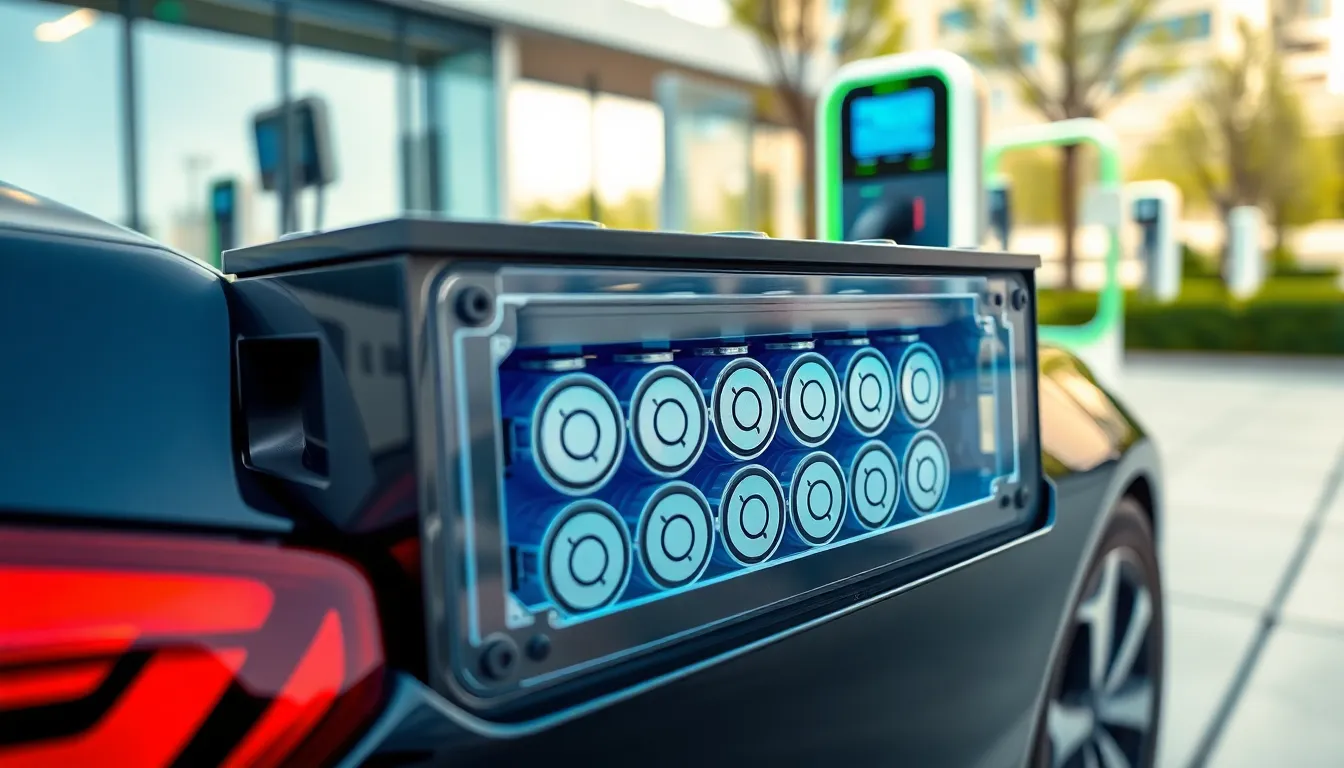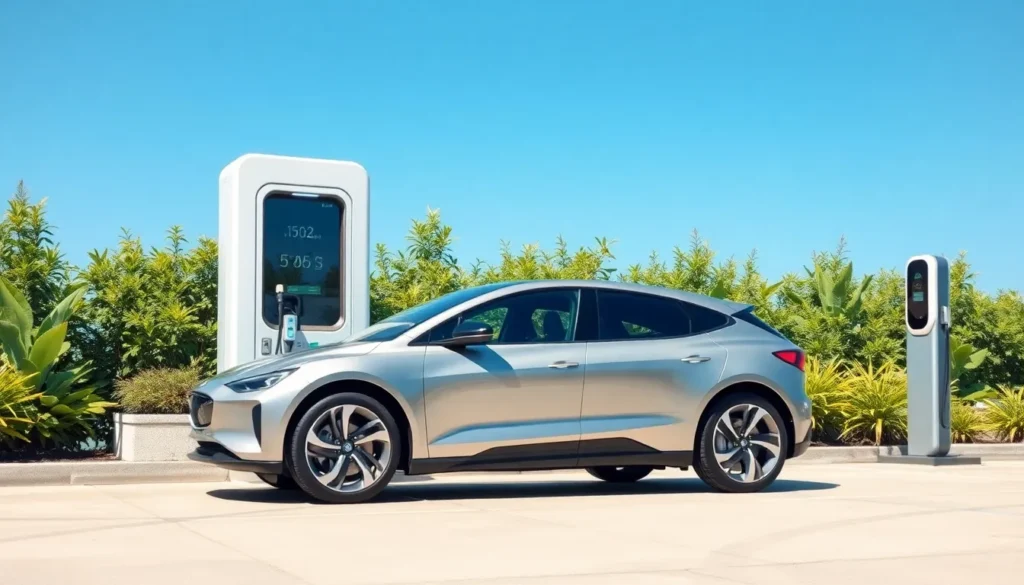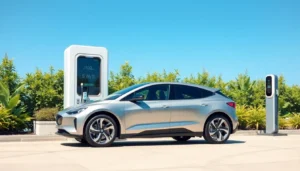Electric vehicles are revolutionizing the way we think about transportation, and they’re doing it with style and a whisper instead of a roar. Imagine zipping down the highway with zero emissions and a battery that powers your ride like a superhero. It’s not magic; it’s science!
Overview Of Electric Vehicles
Electric vehicles (EVs) utilize sophisticated technology to operate efficiently. Their primary source of energy comes from rechargeable batteries, which power electric motors. A typical EV includes components such as an electric motor, an inverter, and a battery management system that regulates battery performance.
Charging an electric vehicle occurs through various methods, including home charging stations, public charging networks, and fast chargers. Home charging setups often use Level 2 chargers, allowing full charging overnight. Faster options like DC fast chargers can replenish significant battery capacity in approximately 30 minutes.
Environmental benefits of electric vehicles stand out. EVs produce zero tailpipe emissions, and lifecycle greenhouse gas emissions significantly decrease compared to gasoline-powered vehicles. According to studies, electric vehicles contribute up to 40% fewer emissions over their lifetimes, showcasing their impact on air quality and climate change.
Driving an electric vehicle provides a smooth and quiet experience. Instant torque from electric motors enhances acceleration, allowing for quick responsiveness on the road. Many models feature advanced technology, such as regenerative braking, which recaptures energy otherwise lost during braking and feeds it back into the battery.
In terms of maintenance, electric vehicles often require less frequent servicing than traditional cars. They do not need oil changes, and their simpler mechanics lead to fewer moving parts. This reduction in complexity lowers long-term maintenance costs, making them a financially savvy choice for many consumers.
Innovative developments continue to emerge in the EV sector, with advancements in battery technology aiming for longer ranges and faster charging times. Manufacturers are investing heavily in research, working to enhance performance and sustainability further. As more people adopt electric vehicles, the future of transportation appears increasingly electric.
Key Components Of Electric Vehicles

Electric vehicles consist of several key components that work together to facilitate their operation. Understanding these components aids in grasping how EVs function efficiently.
Battery Pack
Battery packs store and provide energy for EVs. Lithium-ion batteries dominate the market due to their high energy density and longevity. These battery packs typically range from 20 kWh in smaller models to over 100 kWh in larger vehicles. They play a crucial role in determining a vehicle’s range, influencing how far an EV can travel on a single charge. Battery management systems monitor charge levels, temperature, and overall health, ensuring safe operation.
Electric Motor
Electric motors convert electrical energy into mechanical energy. Operating efficiently, they generate instant torque, providing quick acceleration without delay. Most EVs use AC induction or permanent magnet motors, which optimize performance under various conditions. Motor design impacts efficiency, contributing to the overall range and drivability of the vehicle. Additionally, many models feature regenerative braking, which harnesses energy during deceleration to recharge the battery.
Charging System
Charging systems enable the replenishment of battery power. EVs typically support multiple charging options, including Level 1 (regular household outlets), Level 2 (dedicated home or public charging stations), and DC fast chargers. Level 1 chargers are the slowest, adding about 4-5 miles of range per hour. Level 2 chargers provide 10-60 miles of range per hour, while DC fast chargers can add over 200 miles in under an hour. Charging times vary based on the vehicle and the type of charger, making accessibility crucial for users.
How Do Electric Vehicles Work
Electric vehicles (EVs) operate through a system that efficiently converts electrical energy into mechanical power. The energy conversion begins when the battery pack supplies electricity to the electric motor. Electric motors utilize this electricity to create motion. This process provides instant torque, which enhances the vehicle’s acceleration capabilities. The battery management system monitors battery health, optimizing performance while ensuring safety.
Energy Conversion Process
The energy conversion process is pivotal for electric vehicles. Electric motors transform stored electrical energy into mechanical energy. These motors offer superior efficiency compared to combustion engines, often surpassing 90%. The system draws energy from a lithium-ion battery pack, which stores power and feeds it directly to the motor on demand. This direct power supply enables rapid acceleration, with many EVs capable of reaching 60 mph in just a few seconds. Battery management systems continuously track energy flow, ensuring optimal usage and longevity of battery life.
Regenerative Braking
Regenerative braking significantly enhances the efficiency of electric vehicles. This system recaptures energy during braking, converting it back into electrical energy. When the driver applies the brakes, the electric motor functions as a generator, slowing down the vehicle while generating power. This recovered energy feeds back into the battery pack, extending overall range. Many EV models equipped with regenerative braking can recapture around 70% of energy lost during standard braking. As a result, this feature contributes to longer driving distances and lowers energy consumption, making EVs more sustainable.
Benefits Of Electric Vehicles
Electric vehicles (EVs) offer numerous advantages over traditional gasoline-powered vehicles. Environmental benefits rank high among these, as EVs produce zero tailpipe emissions. Such emissions contribute to improved air quality, addressing climate change issues effectively. Lifecycle greenhouse gas emissions are up to 40% lower for EVs compared to conventional vehicles, reinforcing their eco-friendliness.
Cost savings significantly appeal to many EV owners. Maintenance expenses tend to decrease due to fewer moving parts and no need for oil changes. Operating costs also become more manageable since electricity often costs less than gasoline, providing substantial long-term savings.
Driving experience enhances with electric vehicles. Instant torque delivers rapid acceleration, making them fun to drive. Many EVs include advanced technologies like regenerative braking, which recaptures energy during braking to extend battery range. Quiet operation adds to the overall comfort, creating a serene driving atmosphere.
Convenience emerges as another key benefit. Home charging stations allow owners to conveniently recharge their vehicles overnight. Fast charging options, including Level 2 and DC fast chargers, provide quick replenishment during travel.
Government incentives often support the adoption of electric vehicles. Tax credits, rebates, and other financial incentives lower the initial purchase cost, making EVs more accessible. Local policies may promote the installation of charging infrastructure, further encouraging EV usage.
Electric vehicles provide substantial environmental, economic, and user experience benefits. These factors contribute to their growing popularity, indicating a positive shift towards sustainable transportation solutions.
Electric vehicles represent a significant advancement in the way people approach transportation. With their impressive efficiency and eco-friendly benefits they’re not just a trend but a vital part of a sustainable future. The seamless integration of advanced technology enhances the driving experience while reducing environmental impact.
As battery technology continues to evolve and charging infrastructure expands the appeal of EVs will only grow. Lower maintenance costs and instant torque make them an attractive option for drivers seeking both performance and savings. The shift toward electric vehicles is reshaping the automotive landscape paving the way for cleaner air and a healthier planet.






